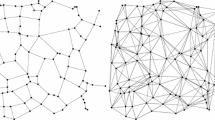Abstract
An algorithm is presented which produces a Delaunay triangulation ofn points in the Euclidean plane in expected linear time. The expected execution time is achieved when the data are (not too far from) uniformly distributed. A modification of the algorithm discussed in the appendix treats most of the non-uniform distributions. The basis of this algorithm is a geographical partitioning of the plane into boxes by the well-known Radix-sort algorithm. This partitioning is also used as a basis for a linear time algorithm for finding the convex hull ofn points in the Euclidean plane.
Similar content being viewed by others
References
A. Aho, J. Hopcroft and J. Ullman,The Design and Analysis of Computer Algorithms, (Addison-Wesley, 1974).
S. G. Akl,A constant-time parallel algorithm for computing convex hulls, BIT 22 (1982), 2.
K. E. Brassel and D. Reif,A procedure to generate Thiessen polygons, Geograph. Analys. 11, No. 3, July 1979.
B. Delaunay,Sur la sphere vide, Bull. Acad. Sci. USSR(VII), Classe Sci. Mat. Nat., (1934), p. 793–800.
W. F. Eddy,A new convex hull algorithm for planar set, ACM Trans. on Math. Softw. 3, (1977), 4.
R. J. Fowler,Deltri. A program for inductively computing Delaunay triangulations, Tech. rep. no. 18, Geogr. Data Struct. Project., Dep. of Geogr., Simon Fraser Univ., Durnaby, British Columbia.
R. L. Graham,An efficient algorithm for determining the convex hull of a finite planar set, Inf. Proc. Letters, vol. 1, (1972), p. 132–133.
P. J. Green and R. Sibson,Computing Dirichlet tessellation in the plane, The Comp. J. 21, (1978), 168–173.
D. T. Lee,Two-dimensional Voronoi diagrams in the Lp-metric, Journ. ACM 27, (1980) 604–618.
D. T. Lee and B. J. Schachter,Two algorithms for constructing a Delaunay trinagulation, Int. J. of Comp. and Inf. Sci. 9, (1980), 3.
M. J. McCullagh and C. G. Ross,Delaunay triangulation of a random set of data for isarithmic mapping, Cartogr. J., Dec. 1980.
B. D. Ripley,Modelling spatial patterns, J. Roy. Stat. Soc. B39, (1977), p. 172–192.
M. I. Shamos and J. L. Bentley,Optimal algorithms for structuring geographic data, in:An advanced study symposium on topological data structures for geographic information systems, Lab. for Comp. Graphics and Spat. Analys., Harvard Univ., Oct. 1977.
M. I. Shamos and D. Hoey,Closest-point problems, Proc. of the Sixteenth Symp. of Found. of Comp. Sci., IEEE, Oct. 1975.
R. Sibson,The Dirichlet tessalation as an aid in data analysis, Scand. J. Stat. 7, (1980), p. 14–20.
R. Sibson,Locally equiangular triangulations, The Comp. J. 21, (1978), 243–245.
Author information
Authors and Affiliations
Rights and permissions
About this article
Cite this article
Maus, A. Delaunay triangulation and the convex hull ofn points in expected linear time. BIT 24, 151–163 (1984). https://doi.org/10.1007/BF01937482
Received:
Revised:
Issue Date:
DOI: https://doi.org/10.1007/BF01937482




